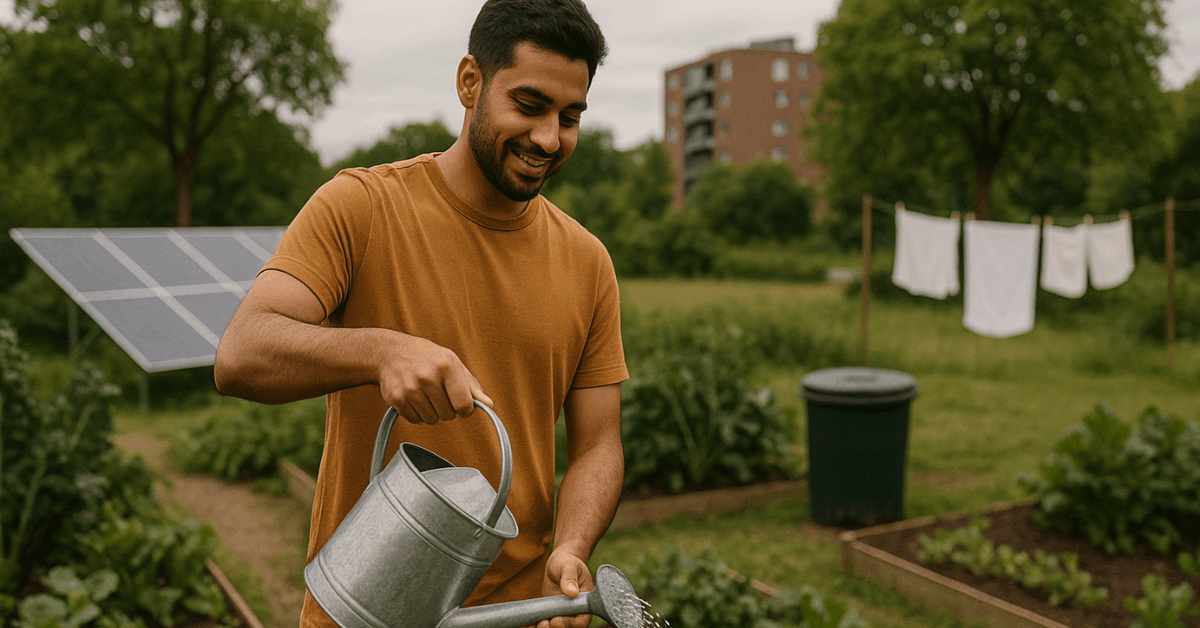Living sustainably is no longer optional—it’s necessary. This article focuses on practical ways to live a more sustainable and eco-friendly life every day.
People often believe sustainable living is expensive or difficult, but that’s not true. These tips will help you take meaningful steps without overcomplicating the process.
Why Sustainable Living Is Essential Now?
Sustainability is about protecting limited resources. Climate change, plastic waste, and energy overuse affect everyone.
Your habits—good or bad—shape the future of the planet. Starting with small changes at home can reduce your environmental footprint significantly.
Your Daily Impact on the Environment
Everything you do leaves a mark—how you eat, travel, and shop. Daily actions like driving, using plastic, or running appliances use energy and generate waste.
When multiplied by billions of people, the effects are massive. That’s why even one person’s efforts can make a meaningful difference.

The Power of Responsible Consumption
Consumers influence industries. When you choose sustainable products, you reduce demand for wasteful practices.
Opting for reusable, recyclable, and ethically made items forces companies to respond. Spending with intention supports a cleaner future.
Support Systems That Promote Sustainability
Governments, nonprofits, and local communities all play a role. Some towns offer compost bins or rebates for energy-efficient appliances.
Look for programs that support environmental choices, especially if you’re on a budget. Advocacy matters—policies change when citizens speak up.
10 Simple Ways to Start Living More Sustainably Today
These ten tips are direct, realistic, and focused on daily actions. Each one helps reduce waste, conserve energy, or improve your impact.
1. Stop Using Single-Use Plastics
Plastic bags, straws, utensils, and water bottles are harmful and unnecessary. Bring your own reusable alternatives wherever you go.
Most stores and cafes accept these without issue. You’ll reduce pollution and save money in the long run.
2. Reduce Home Energy Use
Turn off lights and electronics when not in use. Use LED bulbs and energy-saving appliances.
Adjust your thermostat to avoid overuse of heating or cooling. These steps lower your electric bill and reduce emissions.
3. Eat Less Meat and More Plants
Animal farming creates pollution and uses huge resources. Even skipping meat just twice a week makes a difference.
Try recipes that center on beans, vegetables, or grains. You’ll also save money on groceries.
4. Save Water in Simple Ways
Fix dripping taps and install low-flow showerheads. Don’t run water while brushing your teeth or washing dishes.
Use a bucket for cleaning outdoor areas instead of a hose. These habits reduce waste and lower utility costs.
5. Recycle and Compost Properly
Check local recycling rules to avoid contaminating bins. Rinse containers and separate materials correctly.
Compost kitchen scraps like fruit peels or coffee grounds. These actions divert tons of waste from landfills.
6. Use Eco-Friendly Transportation
Cars produce a large portion of carbon emissions. Walk, bike, or use public transport when possible.
Carpooling is also a good way to cut down on fuel use. Every mile not driven helps the environment.
7. Choose Sustainable Products
Buy items made from recycled or renewable materials. Support brands that use ethical sourcing.
Avoid excessive packaging and single-use designs. Choose quality products that last longer.
8. Limit Fast Fashion
Avoid cheap clothes that wear out quickly. Buy secondhand or from sustainable brands.
Repair clothes when possible. Fewer, better garments reduce waste and save money.
9. Grow Your Own Food
Even a small herb garden reduces your food footprint. Use planters or window boxes if space is limited.
Compost your food waste to enrich the soil. Fresh produce at home is more sustainable.
10. Advocate and Educate
Share what you learn with others. Join local clean-up groups or sustainability events.
Support policies that protect the environment. Educating others amplifies your positive impact.
Tools and Apps to Support Eco-Friendly Habits
Technology can help you stay on track. Use apps to monitor your energy use, track your carbon footprint, or learn to recycle properly. Some platforms suggest sustainable shopping options. Find tools that match your lifestyle and goals.
- JouleBug: This app helps you build sustainable habits with small challenges. It covers energy, water, and waste, and includes community sharing features. You can download it on the App Store or Google Play.
- Oroeco: Tracks your carbon footprint based on your purchases, energy usage, and travel habits. Provides personal tips for reducing environmental impact. Available on Google Play and App Store.
- iRecycle: Helps you find local recycling drop-off points and guidelines. Especially useful for items not accepted in curbside recycling. Download it from the App Store.
- Good On You: Rates fashion brands based on environmental impact, labor ethics, and material use. Helps you choose clothing more responsibly. Visit Good On You for app links and ratings.
- Too Good To Go: Lets you rescue surplus food from local stores and restaurants at a discount. Reduces food waste and saves money. Available on Google Play and App Store.

Common Challenges and How to Overcome Them?
Sustainability often appears to be expensive or too difficult to manage. In reality, most barriers can be overcome with simple adjustments. This list highlights common challenges and guides how to address them without stress.
- Cost concerns: Use what you already have before buying anything new. Repurpose containers, clothing, and tools instead of replacing them.
- Time limitations: Integrate eco-friendly habits into existing routines, like turning off unused lights or bringing reusable bags.
- Lack of knowledge: Rely on trusted sources like Earth911 or local government sites for guidance on recycling and sustainable choices.
- Inconvenience: Choose actions that work for your lifestyle. Sustainability isn’t all or nothing—small steps are valid.
- Peer pressure or lack of support: Join local sustainability groups online or offline to connect with others on the same path.
- Consistency: Build habits gradually and track progress with tools like JouleBug to stay motivated.
Long-Term Benefits of Sustainable Living
You save money through lower utility bills and fewer purchases. Your health improves with cleaner air, better food, and less clutter.
You create a calmer, more intentional life. And most importantly, you help build a better future.
Final Words: Start with One Change Today
Making small eco-friendly choices matters more than ever. This article outlined clear, practical steps to help you live a more sustainable and mindful life.
You don’t need to overhaul everything at once—start with what feels doable. Every step counts toward a better, greener life.












